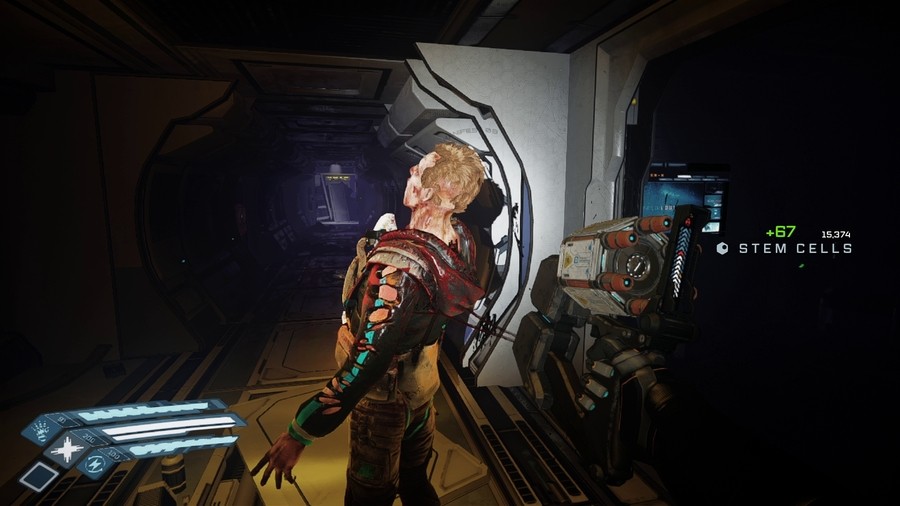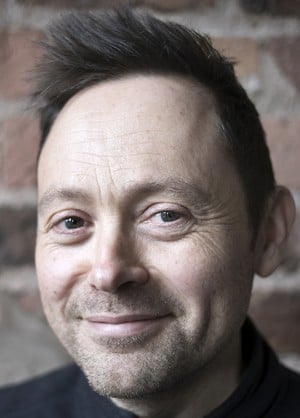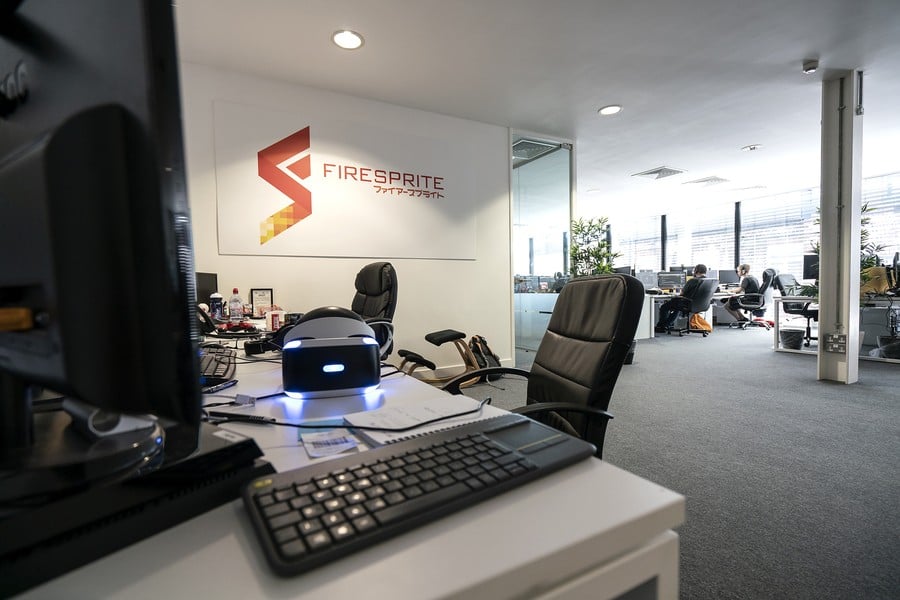
Last month Firesprite Games announced that it was bringing its first-person sci-fi horror game The Persistence to Switch in 2020, and the release date has now been confirmed for 21st May. The studio, originally formed by veterans of Wipeout developer Psygnosis (now SCE Studio Liverpool), released the game exclusively for PlayStation VR back in 2018 and is breaking out of the confines of VR goggles (so no, it's not a Nintendo Labo VR title) onto other platforms soon.
Our lovely counterparts over at sister site Push Square enjoyed the game's addictive roguelike loop and sense of sci-fi dread, so we're intrigued to see how the game translates to Nintendo console. Recently we had the pleasure of asking the game's director Stuart Tilley about how you go about building a 3D roguelike, the team's thoughts on Nintendo's VR experiments with Labo, and the challenges of bringing a Virtual Reality game to non-VR platforms.
Nintendo Life: For those who perhaps missed the original PlayStation VR release of The Persistence, tell us a little about the game.

Stuart Tilley, Game Director: The Persistence is a sci-fi horror game with what we think is a unique twist: it’s a procedurally generated rogue-like game in which you must fight to save a doomed starship, where “death is just the beginning”. The ship the game plays out on had been en route to colonise a planet with a crew of just seven, but with thousands of engrams - the memories of real people - stored in the ship’s computer, to be ‘printed’ on arrival. However, something went terribly wrong along the way, and the computer started printing corrupted mutations who have butchered the crew.
With the ship drifting ever closer to a black hole, you play as a clone of security officer Zimri Eder, and must fight your way through the horrors on board to repair the ship and somehow get back to Earth. Each time Zimri dies a brand new clone of her is printed - a clone that you can upgrade and equip with new gear and weapons, going further on each attempt to fix the ship and to discover the secrets that lie in wait.
Dead Space seems to be an obvious touchstone – what other games or media inspired you while developing the game originally?
You’re certainly right to say that Dead Space was a big influence - it’s one of my all-time favourite games - but we were also inspired by the atmosphere of the Alien movies, playing on the sense that exploring a space you should know could be hiding something that will bring a swift end to your existence. There are many other games that inspired us too, from Dishonored for its amazing ability to contain both stealth and aggressive play strategies, to Rogue Legacy which allows you to inch forward your capabilities with every attempt. It’s really a case of being lifetime of fans of both sci-fi and horror, to be honest. When we were making the Wipeout games at the Liverpool studio, we would always talk about our dream to one day make a ‘scary’ game, and so when we got the opportunity to make The Persistence, we got to combine our two greatest passions.
How did the team approach setting The Persistence apart from its influences and other games which use familiar sci-fi-horror settings? Was this something you worried about before settling on the theme and direction of the game?
For all our games at Firesprite we always strive to make sure we add originality to the games we make – either in creativity or technology. We thought that combining the uniqueness of a roguelike loop in a full 3D game like Dead Space would create an awesome package. We also considered this to be a great fit for such an intense game - which was heightened in VR - as the live-die-repeat loop can give players the chance to take regular breaks from the action.
We also decided that we wanted to have an arsenal of weapons that worked differently that other sci-fi games. In The Persistence you are often the prey, hiding behind cover and looking for a safe place, but the weapons are intentionally overpowered, and when you equip one, you are empowered to be “the hunter” rather than the hunted, taking the fight to the mutants with the odds very much in your favour. The only downside is that these weapons have so little ammo…
A procedurally-generated 3D environment feels novel in a gaming landscape where it sometimes feels like every other release is a run-based roguelike. Incorporating procedurally-generated levels into a 3D game with moments of scripted horror must have been a huge design challenge. How long did it take to develop this system and what were some of the obstacles you encountered?
We created initial prototypes as areas with just a few rooms so that we could prove our movement and weapons systems from the start. A few months later we got an early version of the procedural tech working, generating level layouts with rooms, corridors and boss areas. From that point on, pretty much up until a few weeks before release, we never stopped refining how the levels were generated. As the art set expanded, we realised we wanted more from the system to achieve our desire of the levels feeling hand crafted, even though they’re procedural. As well as tweaks to the layout generation we also invested a lot of time in the balancing of the enemy and item distribution, play testing constantly to find the balance of tension, difficulty and quiet spaces that you expect from a traditional FPS horror game.
Before talking about Switch version specifically, tell us a little about the difficulties of translating a game designed for VR to non-VR platforms. There’s a lot of talk recently on this topic surrounding Valve’s Half-Life: Alyx, but we get the impression that it’s far from a simple job to retool a VR experience successfully for screens that aren’t strapped to your face.
we wanted to ensure the experience scaled across multiple platforms with tailored visual effects and post-processing...we’re super proud of the result on Nintendo Switch
The Persistence was designed to be a sit-down VR experience from the get-go with a more traditional controller setup, so whilst this admittedly isn’t as complex as entirely re-engineering a game with a solely motion control based implementation, it still brings challenges in both UI, UX, and animation. Overall our goal was to maintain parity in player experience between the VR and the non-VR versions where possible.
For us the main challenges were in the areas where players interact with systems and environments that were previously attached to a “look at” system, based on player head tracking in VR. There’s also lot of interaction with the enemies in the game, so fine-tuning the combat systems with hand to hand and projectile-based weapons to feel right was just as important. Another area we had to look at was tailoring the areas of the functional UI - interactions with the map and upgrades and so on – and so we had to rethink these too. Lastly we wanted to ensure the experience scaled across multiple platforms with tailored visual effects and post-processing to suit each particular platform and we’re super proud of the result on Nintendo Switch.

In terms of Switch, what were the biggest technical hurdles you faced when porting the game to Nintendo’s system?
The Switch is a brilliant platform to develop for, but it does obviously differ in specifications to the original platform we developed the game on, so we had to be a little more disciplined in our approach. Taking a technical example such as memory, where there isn’t as much available as the original development platform, the chunky luxuries like the game’s audio took some optimisation work to make sure it was up to the standard we wanted for a survival horror experience.
The UI naturally came with its own challenge for portable mode, and there was a lot of re-adjustment. Text, especially in localised languages, so that took time to sit well on the Switch screen and still be great to look at. We had some big Nintendo fans on the team and getting the controls to feel right with every scheme we support was important to us - attached or detached JoyCons, for instance, as well as the Pro Controller. We've compared our game with other Switch FPS games, and we think The Persistence stands up with the best of them.
We had some big Nintendo fans on the team and getting the controls to feel right with every scheme we support was important to us
From a technical perspective, how does the Switch version stack up against other platforms? Will it have any platform-exclusive features?
We learned throughout the project lifecycle of developing The Persistence on PlayStation 4 VR that really had to optimise the performance so thinking about other platforms in the future factored heavily into this and it gave us a good head start on Nintendo Switch. We’ve further refined our codebase to achieve the best possible performance, so whilst there aren’t platform-exclusive features, we feel that there’s visual, audio, and gameplay parity in keeping with the original experience we developed for PlayStation 4.
As veterans in the VR space, what are your thoughts on Nintendo’s low-fi approach with Labo?
We think Nintendo’s approach with Labo is a brilliant way to introduce players to the magically immersive world of VR. Making all the kits was great fun, and the games allowed you to experience things from an all-new perspective. Toy-Con garage VR is also a brilliant way to make game making accessible too for aspiring creators out there.
Finally, what Switch games have you been enjoying recently?
Super Smash Bros. and Mario Kart have been lunchtime staples in the breakout area here at Firesprite towers. With the move to our team now working remotely, that has obviously been put on hold, but luckily Animal Crossing came out to save the day, so we’re all enjoying this for the time being.
Our thanks to Stuart. The Persistence is scheduled to arrive on Switch on 21st May, and we've had a look at a pre-release build of the game on Switch - look out for our impressions soon.
Like the sound of this? Have you played the original PSVR version? Let us know if you're up for some space-based first-person rogueliking with a little comment below.





Comments 15
Off topic but I wish more VR games were designed to be played without it, as an option for people who can't do VR.
Good on the devs for bringing this to us, I'm curious to see what the reviews are like.
A first person, sci-fi roguelike... rogue was neither first person nor sci-fi. Like calling Street Fighter a one on one combative mariolike... because, you know... jumping and fireballs...
@Daniel36 I think the term "roguelike" is slowly just evolving to mean any game with randomly generated levels amd other elements as well.
So assuming that definition, it fits. Kinda like how every game that involves gradually getting stronger through picking up items and having to backtrack at in while playing are all called "metroidvanias".
I must say, that trailer did absolutely nothing to capture my interest. It makes it look like a dull and lethargic experience. Perhaps it's just not a very good trailer.
@Daniel36 "Roguelike" has come to generally mean any game with procedurally generated content and permadeath. It no longer literally means "Like the game Rogue".
@Kalmaro I get what you're saying but I feel like it will still take away from the kind of "surprise" in the game. For instance, I have Half Life Alyx and I find it pretty freaky in the VR environment. I can't see it being the same not in VR. I guess having options is better than not.
Great read, will definitely consider picking up the physical edition of this game. Also might consider applying to this company too, the director sounds like a cool guy to work with! Great interview @nintendolife
Looks decent but I’ll have to wait and wait for the reviews, seeing if it’s worth investing in...
@Daniel36 I really like your comparison! But Street Fighter is more of a Pong clone, because pressing buttons makes stuff move on screen, one player left, one player right, and some balls flying in between occasionally.
Took me ages to get into this. Kept starting n restarting. Finally stuck with it and it really is incredible. Cant imagine playing it on a flatscreen. In VR theres massive brutes hulking over you. Really is tense and scary.
@Daniel36 I feel like this conversation comes up every time 'rogue-like' is used. There is usually someone saying that the only rogue-likes feature perma-death, procedural generation, no progression between runs and are preferably turn based in a dungeon setting. Pretty restrictive if you ask me.
Hence the term 'rogue-light', which this game is. To me I define rogue-lights as games with permadeath, procedural generation and progression between runs. Anything else is fair game.
To everyone, I know, I know... I am being anal about the term, but it just really grinds my gears. And like has been mentioned, Metroidvania grinds my gears all the same... Just slightly less.
I know Roguelike means any game that features procedural generation and perma-death, but that doesn't make the game "like Rogue" any more than you could say GTA is a Mario64-like simply because it is a 3D, 3rd person game where you can run and jump.
And I know, I know... These games are a specific subgenre and therefore need a title, but... Why Roguelike?
But I know... it shouldn't bother me the way it does... But there you have it...
@Daniel36 At the risk of going way off topic, "Metroidvania" really grinds my gears: what's with the "vania?" SOTN was released TEN years after Metroid (and five years after the genre's pinnacle, Super Metroid). Thus, should be "Metroid-like."
Also, is that Stuart Tilley, or Limmy?
To those who complain about the term "roguelike", so you're saying that, for example, every JRPG must be like the original Dragon Quest or Final Fantasy?? The camera angle, the turn-based combat, the silent main character, etc. I certainly don't think so.
Well, it would be worse if they were called Finalfantasy-likes.
Tap here to load 15 comments
Leave A Comment
Hold on there, you need to login to post a comment...